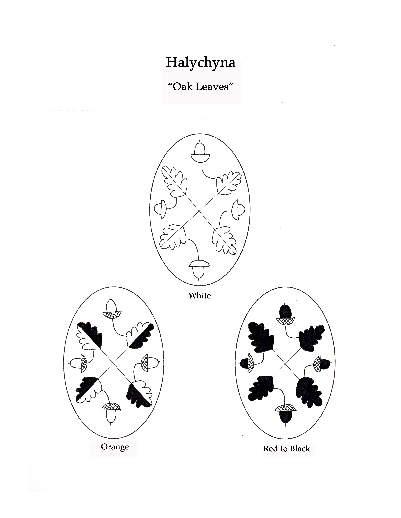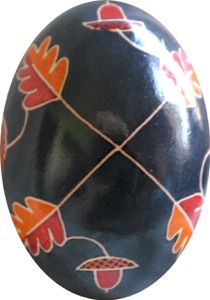Halychyna
Галичина
Halychyna
Галичина

The oak tree was a favorite of the god Perun, the highest god of the pantheon and the god of thunder and lightning. In 980, when Volodymyr the Great ascended to the throne of Kyiv, he erected statues of five pagan gods in front of his palace. Perun was chief among these, represented with a silver head and a golden mustache. After the Christianization of Kyivan Rus, this place became a monastery, which, quite remarkably, continued to bear the name of Perun.
Pysanky with oak symbol (oak leaves and acorns) were powerful and protective. Oak leaves are a fairly common botanical motif. This design is taken from Onyshchuk’s book. Her photo is shown below; the central svarha (curls) was accidentally left off of the pattern sheet.

The colors appear a bit garish, probably as a result of the printing process. The main lines should be white; the orange may actually have been gold/yellow. Onyshchyk does note that this design is from “Lviv.”
Halychyna, often referred to in western books as “Galicia,” is a term that has been used throughout history to denote widely varying territories. It has been used both as an ethnic and political descriptor. Politically, it was a historical region in East Central Europe, currently divided between Poland and Ukraine, named after ancient Ukrainian city of Halych. The nucleus of historic Galicia in Ukraine is formed of three regions of modern western Ukraine: Lviv, Ternopil and Ivano-Frankivsk oblasts.
Ethnographically, the term is fairly meaningless. Binyashevsky used the term “Central Halychyna” in his work; as western Halychyna was the Polish section, he was probably referring to the area around Lviv, which is ethnographically Opillia, Roztochia and Sokal. Because the term is so nebulous, it is hard to discuss the characteristics of its pysanky in any detail. It is better to refer to its distinct ethnographic regions (e.g. Roztochia, Opillia, Podillia, Sokal, etc.).

Technical details: this is a moderately simple pysanka, and a nice design for beginners to try. Use a medium stylus for lines, heavy for waxing in.
This pattern utilizes three dyes: orange, red and black. If you don’t have a nice orange color, yellow can be used instead. It would also look nice with dark brown or dark red as a final color. Another less traditional variation of colors would be yellow (to substitute orange), green (to replace the red in the oak leaves), red and black.
This pysanka utilizes a star division (for pencil lines).
The example above is a bit too spread out; the design would have greater impact if it were a bit more compact, and if the line weight were heavier. The central curls were accidentally left off; they can be added if you like.
Download this pattern sheet:
Back to MAIN Patterns page.
Back to MAIN Regional Pysanky page.
Back to MAIN Traditional Pysanky page.
Search my site with Google
Oak Leaves
Дубове Листя
